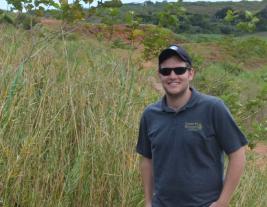
Office: KZN
Email: g.sutton@ru.ac.za
MSc, Entomology, Rhodes University (2017)
PhD, Entomology, Rhodes University (2022)
Guy Sutton is a Research Entomologist currently based in KwaZulu Natal but employed by the Centre for Biological Control at Rhodes University in South Africa. His research combines extensive fieldwork, with laboratory experiments and statistical models to develop, implement and evaluate practical management options for controlling invasive alien plants, using insects and fungal pathogens as biological control agents. Guy’s primary research involves evaluating the prospects for the biological control of African grasses that have become invasive elsewhere in the world, integrating insect systematics, field surveys and host-specificity testing of grass-feeding herbivores.
Guy also has a strong interest in data science/data analysis. He develops and teaches a range of statistics courses and workshops and provides expertise to students and faculty on appropriate and rigorous statistical analyses. Additionally, he develops and maintains two R packages for mapping species distributions and sample size calculations. All his workshops and developmental versions of R packages are available on his GitHub profile (https://github.com/guysutton). He also blogs about analysing ecological data at https://guysutton.netlify.app/.
Research Interests
Publications
Martin, G.D., Magengelele, N.L., Paterson, I.D., Sutton, G.F. (2020). Climate modelling suggests a review of the legal status of Brazilian pepper Schinus terebinthifolia in South Africa is required. South African Journal of Botany 132: 95-102.
Sutton, G.F., Canavan, K., Day, M.D., Den Breeyen, A., Cristofaro, M., McConnachie, A., Goolsby, J.A., & Paterson, I.D. (2019). Grasses as suitable targets for classical weed biological control. BioControl 64: 605-622.
Sutton, G.F. (2019). Searching for a needle in a haystack: where to survey for climatically-matched biological control agents for two grasses (Sporobolus spp.) invading Australia. Biological Control 129: 37-44.
Sutton, G.F., Klein, H., & Paterson, I.D. (2018). Evaluating the efficacy of Hypogeococcus sp. as a biological control agent of the cactaceous weed Cereus jamacaru in South Africa. BioControl 63: 493-503.
Sutton, G.F., Paterson, I.D., & Paynter, Q. (2017). Genetic matching of invasive populations of the African tulip tree, Spathodea campanulata Beauv. (Bignoniaceae), to their native distribution: maximising the likelihood of selecting host-compatible biological control agents. Biological Control 114: 167-175.
Sutton, G.F., Paterson, I.D., Compton, S.G., & Paynter, Q. (2017). Predicting the risk of non-target damage to a close relative of a target weed using sequential no- choice tests, paired-choice tests and olfactory discrimination experiments. Biocontrol Science and Technology 27: 364-377.
Sutton, G.F., Compton, S.G., & Coetzee, J.A. (2016). Naturally occurring phytopathogens enhance biological control of water hyacinth (Eichhornia crassipes) by Megamelus scutellaris (Hemiptera: Delphacidae), even in eutrophic water. Biological Control 103: 261-268.
Last Modified: Thu, 27 Jul 2023 10:23:22 SAST